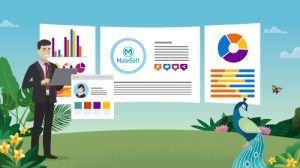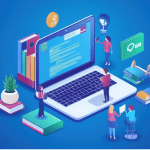MuleSoft has been part of the Salesforce family for over three years. It helps organisations innovate faster by making it easy to connect any application, data source, or device. It does this with Application Programming Interfaces (APIs).
Nearly 90% of business and IT leaders agree that the role of IT has become more important in the last 12 months. Priorities for the coming year will be dominated by enhancing operational efficiency, creating better connected customer experiences, and improving productivity.
The last two years have seen a remarkable acceleration in digital transformation. There have been rapid changes in customer expectations, and seismic shifts in the ways that organisations and their employees work.
There are many barriers to becoming a more effective digital organisation. Here are five of them, and how you can overcome them with MuleSoft:
Integrate legacy data and siloed information
Over two-thirds of organisations have said they find it hard to make changes due to legacy IT. That challenge is even bigger for healthcare (76%), insurance (72%), and public sector (74%) organisations.
When it comes to the public sector, 95% say it’s difficult to modernise their legacy IT systems without disrupting mission-critical processes.
In an attempt to overcome these challenges, many organisations are operating in what Siddharth Rastogi, VP Salesforce/MuleSoft South East Asia, calls a “swivel-chair type of model”.
“Imagine an agent who (swivels) across multiple data sources to respond to a customer,” explains Rastogi. “They are trying to gather all the information in one view so they can engage with the customer. The problem is that much of that information may be locked in legacy systems and spread across silos.”
With MuleSoft, the “swivel” stops. Data can be extracted from any application or system with APIs and unify data to deliver a single, 360-degree view of the customer.
Also, data can be integrated without disrupting mission-critical processes.
“This has been a common challenge for organisations that are building new services or products while wanting to keep their usual engines running,” says Rastogi.
“The nature of MuleSoft means those everyday activities can continue in a secure and sustainable fashion. At the same time, organisations can experiment with new products and services separately. These functions can happen simultaneously.”
Drive greater productivity
MuleSoft research shows the need for greater productivity is the driving factor behind why organisations align their IT teams and business teams. Nearly all organisations surveyed implement automation initiatives to improve productivity. However, 79% of IT decision makers say that integration challenges are holding them back from improved operational efficiency.
“Part of what makes MuleSoft so powerful when it comes to productivity,” says Rastogi, “is the notion of a composable enterprise. This means an enterprise can break down its data and functionality into building blocks that can then be reused to make new capabilities.
“These building blocks can be found again in the future. You can then reuse any number of these blocks to make something new. This notion of discoverability and reuse is fundamental to MuleSoft’s model.
“Imagine you’ve built your first project from scratch. Then you go to your second project and use some of the building blocks from project one. By the time you get to project three and four, the amount you have to make from scratch is becoming smaller. This cuts out a lot of development work and provides a massive bump in productivity.”
Integrate data for improved customer experience
Sixty-five percent of customers say that they often have to repeat information to different parts of the same business. More than half say that it often feels like they are talking to different organisations.
However, 54% of organisations that have better alignment between their IT and business teams have reported an improvement in customer experience. MuleSoft can be a powerful enabler of that critical alignment.
“The goal for any organisation, whatever industry it’s in, is to provide an Amazon-like experience for the customer. The organisation knows and understands the customer and their preferences. They understand where the customer is, and what they want to buy, and can bring all of that together in one seamless experience,” says Rastogi.
To provide that truly connected customer experience, the organisation must access information both internally and externally and connect it in real time. MuleSoft makes that possible. For example, a customer might have a conversation with one part of the organisation in one week and then another interaction with a different part of the organisation the following week. Often, it’s not until much later that the organisation connects these two interactions.
MuleSoft integrates those silos in real time, and agents get an up-to-date picture of all the interactions their customer has had with the organisation.
Keep integrated data secure
Seventy-three percent of IT and business decision makers globally say the integration of disconnected systems causes concerns around security and governance. Added to that, 87% of business and IT leaders agree that concerns around security and governance worries also affect their pace of innovation. This is particularly true when non-technical users are working on integrations.
These are concerns MuleSoft can address with what Rastogi describes as a modern API-led approach. “This means that each of those ‘building blocks’ is wrapped in a security layer managed by the MuleSoft Anypoint Platform.”
MuleSoft can apply security policies right down to the single API level. “We have industry-standard security policies applied across both clusters of APIs and individual APIs,” says Rastogi.
Plug the IT delivery gap
IT teams have been asked to deliver on 30% more projects this year, while their budgets have only grown by around 6%. This is an ongoing trend, and has led to an IT delivery gap at a time when organisations are relying on their IT teams for survival.
As Rastogi explains, it’s a challenge that can be met by MuleSoft’s reuse element. “You’re essentially getting more output for the same input because you’re reusing a lot of elements instead of always developing from scratch.”
One of the benefits of MuleSoft is that it can bring about organisational change. This helps IT teams who may be feeling the strain of shrinking budgets.
“Traditionally, IT is where the bottleneck of requests builds up,” says Rastogi. “But with MuleSoft, simpler processes become accessible to business users, not just IT users. That means IT teams can focus on core elements that need deep technology, integration, security, and governance.”
“MuleSoft Composer puts integration capabilities into the hands of actual business users. They don’t need to have technical expertise. Instead, they can use the drag-and-drop interface to create automated flows.”
MuleSoft is also key to enabling innovation. Instead of working on a small handful of expensive projects, organisations can experiment faster and at a lower cost with MuleSoft’s cloud-based model.
“If the experiment is successful,” says Rastogi, “then the organisation can scale it. If not, it can be trashed with little cost. With MuleSoft, organisations can afford to experiment and innovate more.”
To find out how to make your business more agile, more efficient, and more connected, read about MuleSoft.





![When humans and AI collaborate, they achieve outcomes neither could alone. [Image credit: Aleona Pollauf/Salesforce]](https://www.salesforce.com/ap/blog/wp-content/uploads/sites/8/2025/02/Human_Collaboration-1.webp?w=150&h=150&crop=1&quality=75)














![[Illustration] An AI agent helps a customer service rep solve cases.](https://www.salesforce.com/ap/blog/wp-content/uploads/sites/8/2025/06/Agentforce-for-Service-Relaunch-1500x844-1.jpg?w=150&h=150&crop=1&quality=75)




